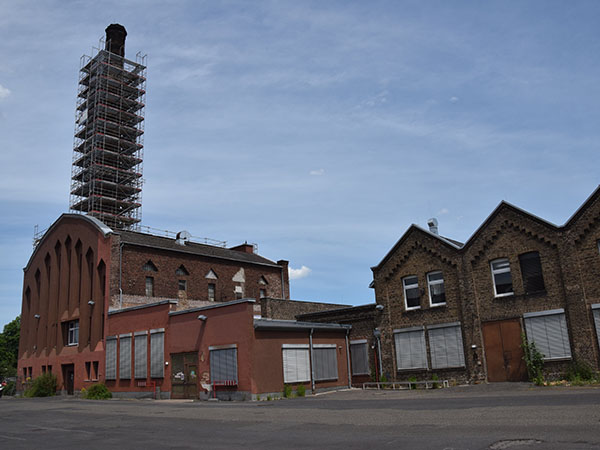
HISTORICAL INFORMATION ON THE OLD JUTE SPINNING MILL
On this page you will find further information on the Old Jute Spinning Mill from the Bonn-Rechtsrheinisch e.V. Monument and History Society.

The Old Jute Spinning Mill
Architecture
The factory site of the former jute spinning mill in Beuel was built in two main construction phases. In 1868, the large spinning and weaving room was built. This is a brick building with ornamental gables and partly high round-arched windows. This was extended along Siegburger Strasse in 1898, so that the built-up area was now twice as large as before. The boiler house with its 46-metre-high chimney is also one of the original buildings on the site. The directors' villa is located on the opposite side of Siegburger Straße in a much altered form.
19th century
Founded in 1868 by the entrepreneur Alfred Hieronymus, the "Vereinigte Jutespinnerei und Weberei AG" at times employed over 1,000 people, making it one of the largest industrial enterprises in Beuel at the time. Production included the processing of raw fibres from India and Pakistan to the finished fabric. Until the construction of the railway on the right bank of the Rhine, the raw jute was transported on barges from Rotterdam to the Beuel shipyard near today's Kennedy Bridge. The coarse fabric was used, among other things, to make sacks for the cement factory near Oberkassel.
The economic crisis in the 1870s led to the re-establishment under the name "Westdeutsche Jutespinnerei und Weberei" (West German Jute Spinning and Weaving Mill) in 1887. In 1898 and 1899, terraced houses were built on the neighbouring Josef-Thiebes-Straße and Paulusstraße as workers' accommodation, which still exist today.
20th century
Due to a lack of raw materials during the First World War, production could only be resumed in 1924 as part of the company "Vereinigte Jutespinnereien und Webereien AG, Hamburg". Until the Second World War, the company developed well overall, except for individual crises. During the Second World War, forced labourers from Poland, France and the Netherlands were used in the factory: "The largest employer of Polish forced labourers in Bonn was the jute spinning mill in the Beuel district. The jute spinning mill obtained its workers directly from two Polish cities. From 1939-1945 there were 2300 Polish forced labourers and 3200 Polish prisoners of war in Bonn." (www.hsozkult.de)
On 4 February 1944, the buildings were largely destroyed in an air raid. Production was already up and running again in 1945 and the number of employees rose to 500 by the 1950s.
Due to the availability of cheaper jute products from the growing regions of India and Pakistan and the increased demand for alternative packaging materials, the company switched to artificial leather and floor coverings in 1954.
In 1961, the site was bought by the Dresdner Bank and operated as a flooring factory until 1965. In 1965, the company was then acquired by Dynamit Nobel AG from Troisdorf and has since traded as United Jute Spinning and Weaving Mills AG. From 1965 to 1980, the former jute spinning mill produced PVC products for Troisdorf Dynamit.
Since 1981, parts of the grounds have been used for cultural events, first by the City of Bonn under the name "Halle Beuel" and since October 2016 by the Bonn Pantheon Theatre. In addition, the buildings house the theatre workshops of the city of Bonn.
Architectural monument
The objects "Facades of the former jute spinning and weaving mill" and "Parts of the workers' housing estates" in Siegburger Straße and Josef-Thiebes-Straße are registered monuments (Denkmalliste Bonn, Baudenkmäler lfd. Nr. A 3939, Nr. A 280).
Source: Kuladig
